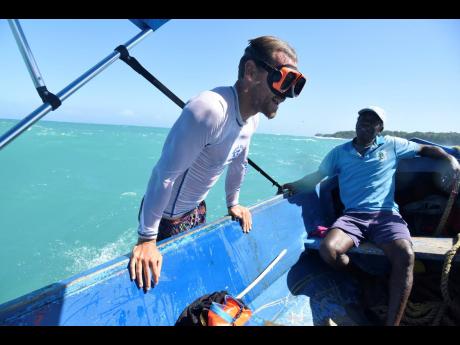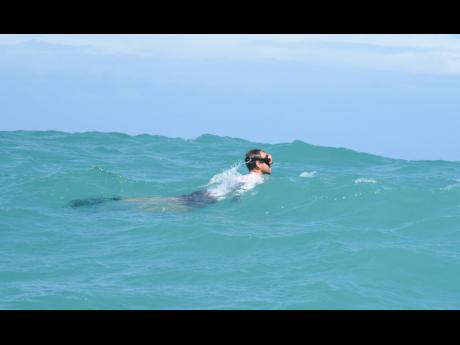Race against time in coral bleaching battle
Expert warns of emergency as 90 per cent of nation’s ‘living reefs’ are dead
In the crystal-clear waters of the Caribbean, where vibrant coral reefs have long been the pride of nations, a silent crisis is unfolding.
A coral-bleaching emergency, driven by rising sea temperatures and climate change, is casting a shadow over the once-thriving marine ecosystems in the region, including in Jamaica and Trinidad and Tobago.
Today we begin a special three-part series delving deep into the heart of the Caribbean, exploring the unprecedented challenges faced by these islands as they grapple with the alarming deterioration of their coral reefs. From the bustling underwater cities teeming with life to the intricacies of coral resilience, we embark on a journey to understand the intricacies of this environmental crisis and the urgent measures needed to safeguard the region’s marine wonders.
Join us as we unravel the tales of the Caribbean’s coral reefs, where the struggle for survival is as vibrant and dynamic as the ecosystems they seek to protect.
The coral reef ecosystem of Jamaica and, to a greater degree, the Caribbean is in grave danger of going extinct.
Experts, speaking with The Gleaner, indicated that this is because of a significant coral bleaching episode that occurred in 2023, brought on by exceptionally high temperatures in what was declared to be the hottest year ever.
Coral bleaching generally occurs when the ocean water becomes too warm, causing the coral to expel microscopic algae called zooxanthellae that live in its tissues. The release of this algae causes the corals to lose their vibrant colours of golden brown, green, yellow, orange or blue as they turn completely white.
It is critical to note that, when a coral bleaches, this does not indicate death.
In actuality, the loss of pigmentation is the coral’s response to a stressful environment, indicating its vulnerability.
As the corals come under increased stress, and if their living conditions are not improved, they die.
If nothing is done, this is what the Caribbean region will soon be confronted with – a barren reef and possibly a barren sea floor.
Felix Charnley, coral reef scientist at the White River Fish Sanctuary in St Ann, told The Gleaner that climate change has been the leading cause of the gradual decline of the Elkhorn and Staghorn coral species, which are among the most significant reef-building species in the Caribbean.
In a December interview, he reported that, in 2023, most of the country’s corals had died during a two-month span - from September to October.
Currently, he said, he could safely report that 90 per cent of the nation’s corals are dead.
July 2023 was officially recognised as the hottest month in recorded history. Similarly, sea surface temperatures were persistently high and above 29 degrees Celsius, the threshold point at which corals begin bleaching.
Jamaica was severely impacted by the heatwaves, as the country had the highest average climate shift index (CSI) of the 175 countries analysed, scoring 4.5 out of a maximum 5, according to a report by Climate Central, a non-profit science research organisation.
Charnley explained that, when he entered a contract with the White River Fish Sanctuary during the last weekend of August 2023, by the second week of September, the entire reef had gone white.
“[Then] by the first week of October, the temperatures were still around 30 degrees (Celsius) [with] 33 degrees being average. All the Elkhorn and Staghorn coral [were] dead – so, it was no longer white, it was brown and covered in algae,” he said.
Corals found to be dark brown or grey in colour signifies death.
It was “shocking”, according to Charnley, to see such a massive loss occur over such a short period of time.
He characterised the occurrence as a “mass mortality” and “mass extinction event”, adding that all the coral fragmentation nurseries had also been wiped out, causing a loss of years of scientific work.
According to international reports, a significant coral bleaching event started in Florida and proceeded southward over the region, culminating in the southern Caribbean.
The National Oceanic and Atmospheric Administration (NOAA) states that the coral reef ecosystem supports more species per unit area than any other marine habi tat, including about 4,000 species of fish, and 800 species of hard corals. For this reason, the coral reef ecosystems are extremely significant.
They also contribute to fish reproduction, shoreline protection, prevention of erosion, and water filtration.
Tourism impact
In a follow-up interview with The Gleaner last Tuesday, Charnley noted that, if this near-extinction event was not urgently addressed, the largest industry to be impacted would be tourism.
“The implications of this event for islands and for Jamaica is enormous, because those corals are what buffer the coastline. So, when that breaks down, if the ecosystem is not self-regenerating, they will erode [and] we will end up with encroaching erosion and we’ll lose our coastal infrastructure and [it will] affect livelihoods and hotels, the people who do business on the coastline,” he said.
“Recreational as well, y’know, scuba [diving], snorkelling. What do we offer to our tourists? Are they really going to come and see a defunct ecosystem?” he questioned.
The Gleaner was informed of the necessity of having an effective restoration project in place. The work that Charnley and the White River Fish Sanctuary are hoping to do is expected to cost approximately US$50,000 in its first phase, and approximately US$500,000 in its subsequent phase.
Among other things, the restoration initiative will involve mapping exercises and the use of assisted fertilisation techniques to increase the corals’ rate of reproduction; which can occur both sexually and asexually.
According to reports, coral reefs require a minimum of nine to 12 years to fully recover from bleaching.
The overall aim of the initiative is to foster climate adaptive corals, Charnley said.
Charnley observed that some of the surviving corals were bleached, including the mountainous star corals (orbicella faveolata), brain corals (diploria labyrinthiformis) and the boulder star corals (orbicella annularis).
Although this is a rarity, he explained that a few corals, including some species of Elkhorn and Staghorn corals, have not bleached, indicating that more research into their biology is required, as this may be a factor in their survival.
“We’ve targeted these two species because not only do they grow slightly faster than other species but those are the ones that will help the reef to recover its function and its complexity ... and that complexity is important because that’s the shelter for the fish, that’s where they live – into all those little crevices,” he said.
He added that fish will lose their entire supply of protein, and that their populations would surely decline, placing a strain on the livelihoods of fishers. Additionally, the public’s fish consumption would likewise decline.
The issue of monetary resources and the need for financial support to advance their reef restoration efforts, particularly for the mapping aspect of the project which requires the continual rental of boats to cover the necessary distances, was also raised.
During his visit to the White River Fish Sanctuary last Tuesday to engage in discussions with executive members, Senator Matthew Samuda, minister without portfolio in the Ministry of Economic Growth and Job Creation, told The Gleaner that the government is committed to preserving the coral population, and would provide monetary assistance to local non-governmental organisations (NGOs).
He acknowledged that the government would need to enlist the support of international partners to secure funds to tackle the issue.
‘Have to move faster’
Samuda added that, because the intervention was so time-sensitive, it had to take place this year.
“We don’t have a lot of time and, admittedly, whereas we are not the only Caribbean nation that faces this, we’re going to have to move faster to play catch up to the environmental changes that we’re facing,” he said.
Samuda, who has responsibility for water, climate change and environment, further emphasised that “significant work” needed to be done on the “resilience” of the coral species in Jamaica, while also understanding that there would undoubtedly be the threat of continued warming of the sea waters because of climate change.
“It’s something that we’ve been tracking very closely through NEPA (National Environment and Planning Agency), the Maritime Authority of Jamaica, and indeed through the [national] fisheries authority,” he said.
“Most of our marine sanctuaries are managed by NGOs with the support and legal support from the government. They’ve designed a series of interventions. So, certainly the team from White River, the teams at Alligator Head Foundation, the teams at the Discovery Bay labs, all have designed their own interventions, because, in many ways, the species and the genetic make-up of your coral is different. So you have to allow each team to do their work,” Samuda explained.
Sewage facilities
He continued that another issue the nation had been facing was that of proper sewage facilities along the coast.
Sewage, according to Samuda, is an environmental pressure from coastal communities which in turn causes an increase in algae cover on the corals and can decrease their ability to withstand heat.
“It’s why ... we’re making significant investments in sewage and it’s a matter of urgency ... . It means we’re gonna have to have serious conversations with all of our citizens who live along rivers also,” he said.
So far, Charnley said he has swum the entire coastline of St Ann and Trelawny and that Dr Andrew Ross, a coastal ecosystems expert, and his team in St James are conducting mapping exercises as well.
Likewise, several NGOs have collaborated and are swimming great distances in an effort to find living corals which will serve as the foundation for a new population of the species that will be used by various scientists to carry out restoration operations on the dying reefs.
“You might think ‘Well, oh, it died so why would you bother to try again?’. [Because] the first corals that survived 2023, which was extreme, it should be able to take us through to the end of the decade and, if we can mix and match them and crossbreed them, we might be able to produce new genes within that population that can withstand, say, 35 degrees warming,” Charnley explained, noting that it was not expected to be able to survive 40 degrees warming temperatures.
Notably, a reduction in corals may also result from recreational abuse such as the touching or removal of corals, disruption caused by boat anchors, marine pollution, overfishing, and dredging, which is the removal of sediments and debris from water bodies.





